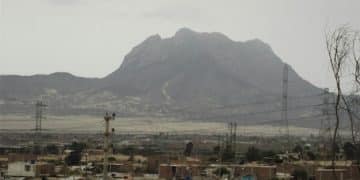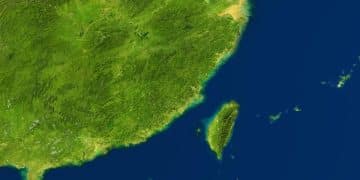US Response to China’s Growing Influence in Latin America

The US is likely to respond to China’s growing influence in Latin America through a combination of economic, diplomatic, and security initiatives aimed at strengthening its partnerships and countering China’s expanding role in the region.
As China’s influence expands in Latin America, the question of how will the US respond to the growing influence of China in Latin America? becomes increasingly critical for understanding the geopolitical dynamics of the region and ensuring U.S. interests are protected. This analysis explores the multifaceted strategies the United States is likely to deploy.
Understanding China’s Rising Influence in Latin America
China’s presence in Latin America has grown substantially over the past two decades, transforming the region’s economic and political landscape. This expansion includes increased trade, investment, and diplomatic engagement, presenting both opportunities and challenges for the United States.
The rapid growth of China’s influence raises concerns in Washington about the long-term implications for U.S. hegemony in the Western Hemisphere. However, China’s influence extends beyond economics, encompassing political and even security dimensions.
Economic Expansion
China has become a major trading partner for many Latin American countries, surpassing the U.S. in some cases. This shift is driven by China’s demand for raw materials and commodities, which Latin America possesses in abundance.
Investment in Infrastructure
Chinese investments in infrastructure projects across Latin America, such as roads, ports, and energy facilities, have further solidified its economic presence, often undercutting US advantages due to lower costs and quicker project timelines.
- Trade Imbalance: Many Latin American economies have become heavily reliant on exporting raw materials to China, leading to trade imbalances and potential vulnerabilities.
- Debt Diplomacy: Concerns have been raised about China’s lending practices, which could lead to unsustainable debt burdens for some countries.
- Geopolitical Influence: As China’s economic footprint grows, it gains greater leverage in political and diplomatic arenas, potentially challenging U.S. interests.
The growing economic entanglement between China and Latin America necessitates a strategic response from the United States to maintain its influence and protect its interests.
The US Response: A Multifaceted Approach
The United States is unlikely to stand idly by as China’s influence deepens in Latin America. Instead, Washington is expected to pursue a multifaceted strategy encompassing economic, diplomatic, and security initiatives designed to counter China’s growing presence while strengthening partnerships with regional allies.
This involves crafting a nuanced approach that leverages U.S. strengths and addresses specific challenges posed by China’s economic and political expansion in the region.
Economic Initiatives
The U.S. may seek to enhance its economic engagement with Latin America through trade agreements, investment incentives, and development assistance, aiming to provide an alternative to Chinese economic dominance.
Also, the U.S. will probably support economic diversification in Latin America, helping countries to reduce their dependence on commodity exports and develop higher-value industries.

- Strengthening Trade Ties: Negotiating new trade agreements or modernizing existing ones to improve access to U.S. markets.
- Investment Promotion: Providing incentives for U.S. companies to invest in Latin America, particularly in sectors with high growth potential.
- Infrastructure Development: Supporting infrastructure projects through financing and technical assistance, often in collaboration with other international partners.
Effective economic initiatives will be essential for the U.S. to remain competitive in the evolving landscape of Latin America.
Diplomatic Engagement and Partnerships
Diplomacy plays a pivotal role in the US strategy to counter China’s increasing sway in Latin America. Building and maintaining strong relationships with regional partners is paramount.
The US relies on its long-standing alliances and historical ties to reinforce its position and address common concerns about Chinese influence.
Strengthening Alliances
The United States invests in strengthening its alliances with key Latin American countries through regular dialogues, joint initiatives, and mutual support on international issues.
Promoting Democratic Values
The U.S. champions democratic values and good governance in Latin America, offering support to countries committed to these principles as a counterweight to China’s more pragmatic, less value-driven approach to foreign relations.
- High-Level Dialogues: Organizing regular summits and high-level meetings to foster collaboration and address mutual concerns.
- Cultural Exchange Programs: Promoting cultural exchange programs to enhance understanding and goodwill between the U.S. and Latin American countries.
- Supporting Civil Society: Providing support to civil society organizations that promote democracy, human rights, and the rule of law.
Diplomatic efforts help reinforce the US role as a trusted partner and counteract the appeal of China’s economic influence.
Security Cooperation and Countermeasures
In addition to economic and diplomatic strategies, the US will most likely enhance security cooperation with Latin American nations to counter China’s growing influence.
This includes military aid, training, and joint exercises, all focused on strengthening regional security and ensuring the U.S. remains a key security partner.
Military Assistance
The U.S. provides military assistance to Latin American countries to enhance their capacity to address security challenges such as drug trafficking, terrorism, and organized crime.
Cybersecurity Cooperation
Given China’s advancements in technology, the U.S. and its allies may collaborate on cybersecurity initiatives to protect critical infrastructure and data from cyber threats.

- Joint Military Exercises: Conducting joint military exercises to improve interoperability and enhance the capabilities of armed forces.
- Intelligence Sharing: Sharing intelligence and information to address common security threats and challenges.
- Maritime Security: Enhancing maritime security cooperation to protect sea lanes and combat illegal activities.
Strengthening security cooperation serves to reassure regional partners and provides a counterbalance to China’s expanding influence in security matters.
Addressing Challenges and Potential Pitfalls
The US response to China’s influence in Latin America is not without its challenges and potential pitfalls. Navigating complex political dynamics and avoiding unintended consequences require careful consideration.
The strategy ought to be attuned to the specific needs and priorities of each nation, keeping away from blanket methodologies that don’t deal with local intricacies.
Political Instability
Political instability in some Latin American countries can complicate U.S. efforts to build strong partnerships and implement effective strategies.
Economic Constraints
Limited resources and competing priorities can constrain the U.S.’s ability to provide substantial economic assistance and investment to Latin America.
- Balancing Interests: Striking a balance between promoting U.S. interests and respecting the sovereignty of Latin American countries.
- Avoiding Protectionism: Ensuring that economic initiatives do not devolve into protectionist measures that harm Latin American economies.
- Managing Expectations: Setting realistic expectations for what the U.S. can achieve and avoiding overpromising.
Acknowledging and addressing these challenges is crucial for crafting a sustainable and effective strategy to counter China’s influence.
The Role of International Organizations
The United States is likely to work through international organizations to amplify its efforts in Latin America and build broader support for its initiatives.
Collaboration with multilateral institutions can provide legitimacy, leverage resources, and foster a more coordinated approach to addressing regional challenges.
The Organization of American States (OAS)
The U.S. may leverage its influence within the OAS to promote democratic values, human rights, and good governance in Latin America.
The Inter-American Development Bank (IDB)
The U.S. works with the IDB to support sustainable development projects and promote economic integration in the region.
- Multilateral Initiatives: Supporting multilateral initiatives to address common challenges such as climate change, poverty, and transnational crime.
- Funding and Technical Assistance: Contributing to international funds that provide financial and technical assistance to Latin American countries.
- Promoting International Norms: Working with international organizations to promote adherence to international norms and standards.
Collaboration with international organizations helps the U.S. build consensus and promote its interests in a more inclusive and effective manner.
| Key Point | Brief Description |
|---|---|
| 🌍 Economic Initiatives | The U.S. can enhance its economic engagement via trade deals and investments. |
| 🤝 Diplomatic Engagement | The U.S. strengthens alliances via dialogues and democracy promotion. |
| 🛡️ Security Cooperation | The U.S. enhances security through military aid and cybersecurity efforts. |
| 🏛️ International Organizations | The U.S. collaborates with bodies like OAS and IDB for broader support. |
FAQ
▼
The US may use trade agreements, investment incentives, and economic diversification support to counter China’s economic influence. These strategies aim to provide alternatives and reduce reliance on Chinese markets.
▼
The US can strengthen ties through high-level dialogues, cultural exchange programs, and supporting civil society. This helps reinforce alliances and promote democratic values throughout Latin America.
▼
The US may enhance security measures by providing military assistance, cooperating on cybersecurity, sharing intelligence, and performing joint military exercises to improve defense capabilities.
▼
International organizations like the OAS and IDB can be leveraged to promote democratic values, support sustainable development, and foster collaboration on regional challenges. Multilateral initiatives also play a key role.
▼
The US might face challenges because of political instability, economic constraints, and the need to balance its own interests with respecting the sovereignty of Latin American nations. These must be carefully navigated.
Conclusion
In conclusion, the US response to China’s growing influence in Latin America will likely involve a combination of economic initiatives, diplomatic engagement, and security cooperation, all while working through international organizations to amplify its efforts and address various challenges in the region. The success of these strategies will depend on adaptability, strong partnerships, and a commitment to mutual respect and shared values.





